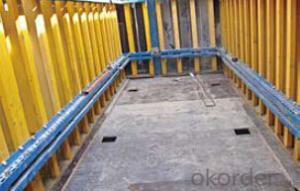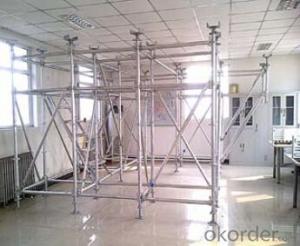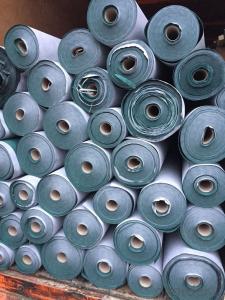Heavy Duty Whole Steel Formwork for Bridge Construction
- Loading Port:
- Tianjin
- Payment Terms:
- TT or LC
- Min Order Qty:
- 300 m
- Supply Capability:
- 100000 m/month
OKorder Service Pledge
OKorder Financial Service
You Might Also Like
1. Structure of Heavy Duty Whole Steel Formwork
A compositional steel formwork system mainly used in the building which has regular structure without beams, the excellent formwork system can make the integral pouring for the wall & slab easily achieved.
2. Main Features of Heavy Duty Whole Steel Formwork
◆ High stiffness, make perfect shape for concrete.
◆ Easy operation, save labor and force.
◆ Fast forming, repeatedly turnover.
◆ No assembling, easy operation with formed formwork.
◆ High stiffness, make perfect shape for concrete.
◆ Repeatedly turnover is available.
◆ Widely applied range, such as building, bridge, tunnel, etc.
3. Heavy Duty Whole Steel Formwork images
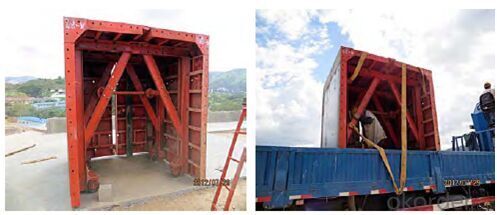
4. Heavy Duty Whole Steel Formwork Specifications
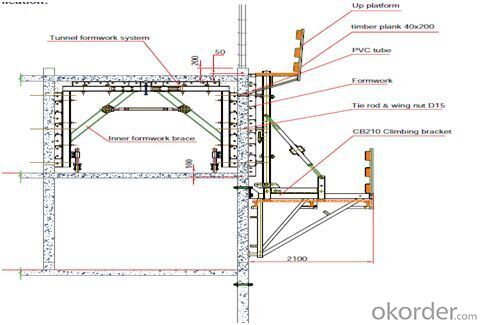
5. FAQ of Heavy Duty Whole Steel Formwork
1) What can we do for you?
.We can ensure the quality of the Heavy Duty Whole Steel Formwork and avoid extra expenses for customers.
.We can provide you the professional technical team.
.We can provide professional building proposal for your projects.
2) What promises can be done by us?
. please feel free to write us for any QUOTE.
. If need any technical and building assistance, we could provide on-site professional staff for instruction.
. Please DO check goods when courier knocks your door and contact us asap if any issues.
3) What about of our after-sale services?
. Response will be carried out in 24hours after receiving any complain or request.
. Any formwork cost can be refund after order is confirmed.
. If the products are not based on the requirements, there will be the relevant compensations made for you.
4) What about the package and shipping time?
.Packing: wood package and adhesive tape
.Shipping: by sea
Shipping time: Normally small orders, it just1week business days to arrive your hand; When comes to the customs declaration, it may need 2weeks.
- Q:What are the different types of coatings used on steel formwork?
- Steel formwork can be protected and its performance enhanced through the use of various types of coatings. These coatings are typically applied to the steel surface to prevent corrosion, increase durability, and improve the overall appearance of the formwork. One commonly used coating for steel formwork is epoxy. Epoxy coatings are recognized for their excellent resistance to chemicals, abrasion, and impact. They create a hard, smooth, and long-lasting surface that can withstand harsh environments and heavy usage. Additionally, epoxy coatings adhere well to the steel surface, ensuring long-term protection against corrosion. Another frequently employed coating for steel formwork is galvanizing. Galvanizing involves applying a zinc layer to the steel surface through hot-dip galvanization. This coating provides exceptional corrosion resistance and helps prolong the formwork's lifespan. Galvanized coatings are particularly suitable for formwork utilized in outdoor or marine environments where exposure to moisture and severe weather conditions is expected. Polyurethane coatings are also utilized on steel formwork to offer high levels of protection and durability. These coatings exhibit outstanding resistance to chemicals, abrasion, and UV radiation, making them ideal for formwork used in construction projects where exposure to harsh elements is common. Furthermore, polyurethane coatings provide a smooth and glossy finish, enhancing the formwork's appearance. Apart from these coatings, there are numerous other types available, such as acrylic coatings, polyester coatings, and powder coatings. Acrylic coatings are known for their strong adhesion and resistance to weather conditions, while polyester coatings offer excellent durability and chemical resistance. On the other hand, powder coatings are applied electrostatically and deliver a highly protective and decorative finish. Ultimately, the choice of coating for steel formwork depends on the specific requirements of the project, including anticipated environmental conditions, desired durability, and aesthetic preferences. It is crucial to carefully consider the properties and advantages of each coating type to ensure that the formwork is adequately protected and performs optimally throughout its lifespan.
- Q:Can steel formwork be used in areas with high seismic activities?
- Yes, steel formwork can be used in areas with high seismic activities. Steel is known for its strength and durability, making it a suitable material for construction in earthquake-prone areas. Steel formwork has the ability to withstand the lateral forces and vibrations generated by seismic activities, ensuring the safety and stability of the structure. Additionally, steel formwork is highly flexible and can be easily designed to accommodate different shapes and sizes, allowing for customized construction solutions in high seismic areas. Overall, steel formwork is a reliable and effective choice for construction projects in regions with high seismic activities.
- Q:What materials are used in steel formwork construction?
- A sturdy and durable structure is typically created in steel formwork construction by using a combination of materials. The main material used is steel, which provides excellent strength and rigidity to support the weight and pressure of the concrete during casting. In addition to steel, other materials such as plywood or timber are used to construct the formwork panels. These panels are made of high-quality plywood or timber boards that are strong enough to bear the weight of the concrete without bending or warping. To enhance the formwork structure, steel bars or rods are strategically placed within the formwork for additional support. This prevents any deformation or collapse of the structure while pouring the concrete. Various connectors, fasteners, and accessories are also utilized in steel formwork construction. These include bolts, nuts, clamps, wedges, and pins, among others. These components securely join and hold the formwork panels and reinforcement bars together, ensuring a stable and rigid structure. Overall, steel formwork construction involves using steel, plywood or timber, reinforcement bars, and various connectors and accessories. These materials collaborate to create a robust and reliable formwork system capable of withstanding the pressures and forces exerted during the concrete casting process.
- Q:What are the different types of steel formwork systems?
- Construction projects commonly utilize various types of steel formwork systems, which serve as temporary structures or molds to support concrete during pouring and curing. Below are several types of steel formwork systems commonly used: 1. Traditional steel formwork: This prevalent system involves connecting individual steel panels using clamps or pins. These panels can be adjusted to create different shapes and sizes, and they are straightforward to assemble and disassemble. 2. Modular steel formwork: This system relies on prefabricated steel modules that are interconnected to form larger formwork assemblies. The modules are lightweight and easy to handle, making them ideal for repetitive use in projects with consistent shapes and sizes. 3. Tunnel formwork: Specifically designed for tunnel or underground structure construction, this system utilizes interconnected steel panels to create a seamless, continuous mold. It is commonly employed in large-scale infrastructure projects like subway systems or underground parking garages. 4. Climbing formwork: This system is suitable for tall structures such as high-rise buildings or towers. It comprises vertically extendable steel formwork panels that are attached to a climbing mechanism. This mechanism facilitates lifting and repositioning of the panels at each level, enabling uninterrupted construction. 5. Slip formwork: For vertical structures like walls or columns, slip formwork is utilized. It involves a moving formwork that is continuously filled with concrete as it ascends. Steel rods or cables support the formwork, allowing for the swift construction of tall and straight structures. These examples represent only a portion of the diverse steel formwork systems available. The selection of the most suitable system depends on the project's specific requirements, including structure size, shape, complexity, desired construction speed, and cost-effectiveness.
- Q:Can steel formwork be used in renovation and refurbishment projects?
- Yes, steel formwork can be used in renovation and refurbishment projects. Steel formwork is a versatile and durable option that can be used for various construction purposes, including renovation and refurbishment projects. Its strength and stability make it suitable for both small-scale and large-scale projects. One of the main advantages of using steel formwork in renovation and refurbishment projects is its reusability. Steel formwork can be easily dismantled and reassembled, allowing it to be used multiple times. This makes it a cost-effective choice, as it reduces the need for constant replacement or repair of formwork materials. Moreover, steel formwork provides a high level of precision and accuracy, ensuring that the desired shape and dimensions are achieved during the renovation or refurbishment process. This is particularly important when working on intricate designs or when preserving historical structures. Steel formwork also offers excellent load-bearing capacity, which is necessary in renovation projects where existing structures need to be reinforced or altered. It can withstand the pressure exerted by concrete pouring, ensuring the stability and safety of the overall construction. In addition, steel formwork is resistant to environmental factors such as moisture and extreme temperatures, making it suitable for both indoor and outdoor renovation and refurbishment projects. It can withstand the wear and tear associated with construction activities, ensuring its longevity and reliability. Overall, steel formwork is a reliable and efficient choice for renovation and refurbishment projects. Its versatility, reusability, precision, load-bearing capacity, and resistance to environmental factors make it a preferred option for contractors and builders in these types of construction works.
- Q:How is steel formwork installed?
- Steel formwork is installed in a systematic and efficient manner to ensure accurate and sturdy construction. The process typically involves the following steps: 1. Planning and preparation: Before installing steel formwork, careful planning and preparation are essential. This includes determining the desired shape and dimensions of the concrete structure, calculating the required amount of steel formwork panels and accessories, and ensuring all necessary tools and equipment are available. 2. Site preparation: The construction site needs to be prepared adequately. This involves clearing the area of any debris or obstacles, leveling the ground, and ensuring a solid foundation. 3. Positioning and alignment: Steel formwork panels are positioned and aligned according to the planned structure. This is done by connecting and securing the panels using various methods, such as clamps, nuts, bolts, or pins. It is crucial to ensure proper alignment and tightness to prevent any leakage or seepage of concrete. 4. Reinforcement installation: If required, steel reinforcement bars are installed within the formwork to provide additional strength and support to the concrete structure. These reinforcement bars are precisely placed according to the structural design and secured firmly to the formwork panels. 5. Formwork bracing: To ensure stability and prevent any deformation during the pouring and curing of concrete, steel formwork needs to be adequately braced. Bracing helps distribute the load evenly and maintain the desired shape of the structure. Horizontal and vertical bracing systems are used to provide the necessary support and rigidity. 6. Pouring and compacting concrete: Once the steel formwork is securely in place and braced, concrete is poured into the formwork. The concrete is then compacted using vibrators or other suitable equipment to remove any air bubbles and ensure proper adhesion and density. 7. Curing and removal: After the concrete is poured and compacted, it needs to be cured to achieve maximum strength and durability. Curing can be done by various methods, such as covering the structure with plastic sheets or water spraying. Once the concrete has sufficiently cured, the steel formwork can be removed carefully, starting from the top and gradually moving downwards. It is important to note that the installation process may vary depending on the specific project requirements, complexity of the structure, and the type of steel formwork used. Therefore, it is always advisable to consult with experienced professionals or engineers to ensure proper installation and adherence to safety standards.
- Q:Can steel formwork be reused?
- Indeed, steel formwork has the ability to be reused. It is a material that is both durable and robust, capable of enduring multiple uses. Compared to other formwork materials like timber or plywood, steel formwork boasts a longer lifespan. One of its key advantages lies in its simplicity to dismantle and reassemble. This feature permits the formwork to be used again in different construction projects, thereby reducing the necessity for new materials and resulting in cost savings. Moreover, steel formwork exhibits resistance to weather conditions and moisture, which adds to its longevity. It can handle the pressure exerted by concrete during pouring and curing without any warping or deformation, ensuring a consistent and high-quality outcome. In addition, steel formwork is easily cleaned and maintained, rendering it suitable for reuse. After each use, the formwork can be cleaned and inspected to guarantee its viability for the next project. Any necessary repairs or replacements can be carried out to ensure its structural integrity. To sum up, due to its durability, strength, resistance to weather conditions, and ease of maintenance, steel formwork can be reused. By reusing steel formwork, not only are costs saved, but sustainable construction practices are also fostered by reducing waste and conserving resources.
- Q:What are the different accessories required for steel formwork maintenance?
- The different accessories required for steel formwork maintenance include the following: 1. Formwork cleaning agents: These are used to remove any concrete residue or build-up on the steel formwork. They help in maintaining the smooth surface of the formwork and prevent any damage or corrosion. 2. Formwork release agents: These are applied to the steel formwork before pouring concrete to prevent it from sticking to the formwork. They help in easy removal of the formwork after the concrete has cured. 3. Formwork patching compounds: These are used to repair any damages or imperfections on the steel formwork. They help in maintaining the structural integrity of the formwork and ensure its longevity. 4. Formwork oil or grease: These lubricants are applied to the moving parts of the steel formwork, such as hinges or sliding mechanisms. They help in smooth operation and prevent any friction or wear and tear. 5. Formwork ties and connectors: These are used to secure the formwork panels together and ensure stability during concrete pouring. They should be regularly inspected and replaced if damaged or worn out. 6. Formwork wedges and pins: These are used to align and secure the formwork panels in place. They should be checked regularly to ensure proper positioning and stability. 7. Formwork clamps and brackets: These accessories are used to support and hold the formwork panels in position. They should be inspected for any signs of damage or weakness and replaced if necessary. 8. Formwork cleaning tools: These include brushes, scrapers, and high-pressure washers, which are used to clean the steel formwork. Regular cleaning helps in maintaining the formwork's appearance and prevents the accumulation of dirt or debris. 9. Formwork storage and transportation equipment: These include racks, trolleys, or storage containers, which are used to store and transport the steel formwork safely. Proper storage and transportation ensure the formwork's longevity and prevent any damage or distortion. Overall, the different accessories required for steel formwork maintenance are crucial to ensure the formwork's optimal performance, durability, and safety during concrete construction projects.
- Q:Can steel formwork be used for staircases and ramps?
- Steel formwork is indeed capable of being utilized for the construction of staircases and ramps. It possesses a great deal of versatility and durability, making it an ideal choice for the creation of intricate shapes and structures. The strength and stability that it offers are essential for supporting the weight and loadings associated with staircases and ramps. Moreover, the assembly and disassembly of steel formwork can be accomplished with ease, allowing for efficient construction and customization of staircases and ramps. Its flexibility enables the creation of diverse designs and sizes that cater specifically to the requirements of a given project. In conclusion, when considering the construction of staircases and ramps, the use of steel formwork is highly suitable due to its strength, durability, versatility, and user-friendly nature.
- Q:How is steel formwork secured to the ground?
- To ensure stability and safety during the construction process, there are several methods available for securing steel formwork to the ground. Ground anchors are commonly used, typically made of steel or concrete. These anchors are driven into the ground at regular intervals along the formwork's perimeter. Steel rods or cables are then used to connect the anchors with the formwork, creating a strong and secure attachment to the ground. Alternatively, steel stakes can be employed when the ground is unsuitable for ground anchors, such as in rocky or uneven terrains. These stakes are driven into the ground at regular intervals, and the formwork is attached to them using various clamps or brackets. In addition to ground anchors and stakes, concrete footing or foundation can also be utilized to secure the steel formwork to the ground. This method involves pouring concrete footings or foundations at regular intervals along the formwork's perimeter. Bolts or other fasteners are then employed to attach the formwork to the concrete, ensuring a solid and stable connection. The specific method for securing steel formwork to the ground may vary depending on the construction project's requirements and the ground conditions. Following the manufacturer's instructions and consulting with structural engineers is crucial to ensure the proper installation and secure attachment of the formwork to the ground.
1. Manufacturer Overview |
|
|---|---|
| Location | |
| Year Established | |
| Annual Output Value | |
| Main Markets | |
| Company Certifications | |
2. Manufacturer Certificates |
|
|---|---|
| a) Certification Name | |
| Range | |
| Reference | |
| Validity Period | |
3. Manufacturer Capability |
|
|---|---|
| a)Trade Capacity | |
| Nearest Port | |
| Export Percentage | |
| No.of Employees in Trade Department | |
| Language Spoken: | |
| b)Factory Information | |
| Factory Size: | |
| No. of Production Lines | |
| Contract Manufacturing | |
| Product Price Range | |
Send your message to us
Heavy Duty Whole Steel Formwork for Bridge Construction
- Loading Port:
- Tianjin
- Payment Terms:
- TT or LC
- Min Order Qty:
- 300 m
- Supply Capability:
- 100000 m/month
OKorder Service Pledge
OKorder Financial Service
Similar products
New products
Hot products
Hot Searches
Related keywords






